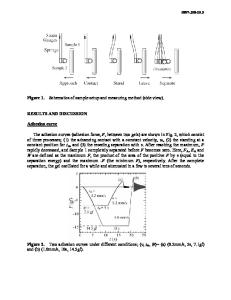Polymer Chain Deformation in Stretched and Swollen Elastomers
- PDF / 529,575 Bytes
- 15 Pages / 420.48 x 639 pts Page_size
- 6 Downloads / 309 Views
POLYMER CHAIN DEFORMATION IN STRETCHED AND SWOLLEN ELASTOMERS ROBERT ULLMAN DEPARTMENT OF NUCLEAR ENGINEERING, ANN ARBOR,
UNIVERSITY OF MICHIGAN
MI 48109-2104
ABSTRACT In the early theories of rubber elasticity, the retractive force and change in free energy of a stretched specimen were calculated
from the deformation of the polymer chains of which the rubber network was formed. The mean chain deformation was presumed to be the same as that of the macroscopic specimen, an assumption which seemed reasonable,
but could not be confirmed
experimentally.
Small angle neutron scattering (SANS) made measurement of chain dimensions possible, and it was soon discovered
[11, (2] that the actual relation between dimensional changes of the polymer chain and deformation of the
specimen was not at all what had been assumed. SANS studies of carefully prepared elastomeric networks provide the most direct experimental information required for a molecular theory of rubber elasticity,
and have stimulated
many new developments. INTRODUCTION Polymer molecules are detected by SANS by substituting deuterium (D) for ordinary hydrogen (H) in a portion of the molecules in a specimen. The H and D macromolecules appear in sharp contrast in the neutron beam, and thus one species can be detected against a background of the other in a scattering measurement. The important experimental parameter is the wave vector, _, whose magnitude, designated as q equals (41T/,') sin (0/2) where( is the wave length of the neutrons and() is the scattering angle. The radius of gyration, Rg, of the labeled polymer chains is calculated unambiguously from the decay of the scattering intensity with q at low q.
Mat Res. Soc. Symp- Pronc Vol. 79. 1987 Materials Research Society
Where
226
polymer molecules assume an anisotropic shape as they do when rubber is stretched uniaxially, projections of the radius of gyration in various azimuthal directions are also directly calculated from the scattering function. Much information is
inherent in the scattering function
other than the radius of gyration. merits further attention, which it
This additional
information
will not receive here.
Predictions of the Theory Consider a polymer network containing N polymer chains each with n monomer units. The molecular weight of the polymer, M, equals n MO, where Mo is the molecular weight of the The chains are linked at their endpoints,42
monomer.
chains
to each crosslink junction. These chains obey Gaussian statistics W(R)
W(R)
is
-
n b2
exp [-aR2
(la)
= 3/2a
(ib)
the probability that the ends of the chain are separ-
ated by R b,
(a/T)3/2
according to
,
designates an average over all
a Kuhn statistical
monomer units.
chains, and,
element, characteristically contains 3-10
SANS experiments have given strong support to
the hypothesis that chain dimensions are unchanged by crosslinking
[11,
[31,
[4].
Eqs.
(la) and (lb) are equally valid
before and after network formation. It
is
important to recognize that once the network is
formed,
Data Loading...










